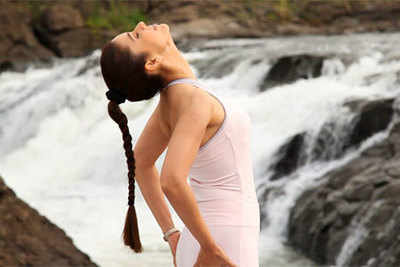- News
- lifestyle
- health-fitness
- fitness
- Tibetan yoga heals your body and mind
Trending
This story is from October 11, 2014
Tibetan yoga heals your body and mind
Borrow from the ancient wisdom of Tibetan monks with the short and simple 15-minute sequence of five poses.

Borrow from the ancient wisdom of Tibetan monks with the short and simple 15-minute sequence of five poses.
One simple daily practice can unify your body, mind and soul, keep you in shape and even regulate blood pressure. All you need is enough floor space to accommodate your body and 15 minutes of your time ever day. It’s perfect for those with small homes and executives who travel frequently on business since the routine can be completed in small spaces like hotel rooms.Fitness junkies can use it as a warm up for a workout.
Says Raageshwari Loomba, who healed herself of Bells Palsy through regular practice of Tibetan yoga, “It’s the secret to why monks have unbelievable energy, are constantly on their feet, eat very little food and yet don’t age. I am a devoted Tibetan yogi now. Every day, I do a repetition of the five postures called the five rites. They help me stay positive, be happy and kind,” says Loomba who has taken to teaching the practice all over the world.
Says practitioner Rajen Menen, “Each posture is dedicated to a particular chakra. Once you start Tibetan yoga, you align your chakras. You feel energetic and your metabolism is high. As with all forms of holistic body work, sunrise and sunset are the best times to start your practice.” Loomba and Menen outline the five rites of Tibetan yoga and the methods.
When you begin, try to do 1 or 3 repetitions of each exercise. After a week, try to do 3 repetitions, then pause and try 3 more. Once you've achieved 21 repetitions of each exercise, you don't need to go on to more repetitions. If you feel great after doing 21 repetitions of each movement, feel free to add another session later in the day.
Rite 1
Similar to sufi whirling, this is a playful exercise.
Method: Stand straight. Extend your arms at shoulder level, away from your body and spin clockwise. Breathe in and out as you spin. Look directly in front of you but don’t focus on anything. Let your vision blur, like that of a whirling dervish. Turn up to 21 times. Speed is not important, it’s more about being playful. Beginners can do fewer turns if they feel dizzy. When you stop spinning breathe deeply from your stomach until you regain balance and your head stops spinning.
Rite 2
This exercise has similar benefits as leg raises and bending at the waist.
Method: Lie on your back with your arms to your side and palms up. Keep your legs straight. Breathe in and raise your legs off the ground as high as possible and lift your head off the ground, bending your neck with your chin falling toward your chest. If you feel discomfort, place your hands under your buttocks for support. Breathe out as you lower your limbs and return to the initial flat position. Do this 21 times.
Rite 3
This exercise is like doing a neck warm-up in the morning.
Method: Kneel with your legs together. Extend your arms and keep the palms of your hands to the side of your thighs. Drop your chin to your chest, raise your head and lean back while breathing out. Move your hands to the back of your thighs and let them drop lower and support your weight. Crane your head and neck backward and relax your lower spine. Start exhaling as you come forward again to the starting position. Do this 21 times. Maintain a steady movement while going backward and forward. As you gain practise, try the movement with your eyes closed.
Rite 4 This exercise benefits your posture and acts as a wrist warm-up.
Method: Sit on the floor, legs a little less than shoulder width apart, arms to your sides with hands extended flat on the ground and fingers pointed forward. Drop your head toward your chest. Inhale as you raise your butt off the ground while bending your knees. Shift your weight to your arms and and legs. Continue to raise your buttocks until your torso and thighs are parallel to the ground. Let your head fall back. Breathe out as you return to the sitting position with your head forward. Do this 21 times.
In the beginning, you might not be used to your body weight on your wrists. Doing some wrist warm-ups before you begin can prevent discomfort.
Rite 5
This pose is like moving from the cobra pose to the downward dog pose in traditional yoga.
Method: Get on the floor on your hands and knees in push-up position. The hands and legs will be a little less than shoulder width apart. Start inhaling as you come up on your toes with weight in your arms. Straighten your legs, arch your back and lean your head back. Do not let any of your body touch the ground except your toes and hands. Start exhaling as you bend at the waist. Bend your knees, push your butt up in the air and make an inverted V shape with your legs and arms straight. Tuck your chin toward your chest. Try to keep your feet flat on the ground. Do this 21 times.
After the 5 rites
After you have completed all the five rites, lie flat on your stomach with your arms stretched out. Close your eyes and feel your heart pumping and blood circulating through your body. Wait until your breath returns to normal. Take a few breaths and relax for one minute.
One simple daily practice can unify your body, mind and soul, keep you in shape and even regulate blood pressure. All you need is enough floor space to accommodate your body and 15 minutes of your time ever day. It’s perfect for those with small homes and executives who travel frequently on business since the routine can be completed in small spaces like hotel rooms.Fitness junkies can use it as a warm up for a workout.
Says Raageshwari Loomba, who healed herself of Bells Palsy through regular practice of Tibetan yoga, “It’s the secret to why monks have unbelievable energy, are constantly on their feet, eat very little food and yet don’t age. I am a devoted Tibetan yogi now. Every day, I do a repetition of the five postures called the five rites. They help me stay positive, be happy and kind,” says Loomba who has taken to teaching the practice all over the world.
Says practitioner Rajen Menen, “Each posture is dedicated to a particular chakra. Once you start Tibetan yoga, you align your chakras. You feel energetic and your metabolism is high. As with all forms of holistic body work, sunrise and sunset are the best times to start your practice.” Loomba and Menen outline the five rites of Tibetan yoga and the methods.
Tibetan yoga for beginners
When you begin, try to do 1 or 3 repetitions of each exercise. After a week, try to do 3 repetitions, then pause and try 3 more. Once you've achieved 21 repetitions of each exercise, you don't need to go on to more repetitions. If you feel great after doing 21 repetitions of each movement, feel free to add another session later in the day.
Rite 1
Similar to sufi whirling, this is a playful exercise.
Method: Stand straight. Extend your arms at shoulder level, away from your body and spin clockwise. Breathe in and out as you spin. Look directly in front of you but don’t focus on anything. Let your vision blur, like that of a whirling dervish. Turn up to 21 times. Speed is not important, it’s more about being playful. Beginners can do fewer turns if they feel dizzy. When you stop spinning breathe deeply from your stomach until you regain balance and your head stops spinning.
Rite 2
This exercise has similar benefits as leg raises and bending at the waist.
Method: Lie on your back with your arms to your side and palms up. Keep your legs straight. Breathe in and raise your legs off the ground as high as possible and lift your head off the ground, bending your neck with your chin falling toward your chest. If you feel discomfort, place your hands under your buttocks for support. Breathe out as you lower your limbs and return to the initial flat position. Do this 21 times.
Rite 3
This exercise is like doing a neck warm-up in the morning.
Method: Kneel with your legs together. Extend your arms and keep the palms of your hands to the side of your thighs. Drop your chin to your chest, raise your head and lean back while breathing out. Move your hands to the back of your thighs and let them drop lower and support your weight. Crane your head and neck backward and relax your lower spine. Start exhaling as you come forward again to the starting position. Do this 21 times. Maintain a steady movement while going backward and forward. As you gain practise, try the movement with your eyes closed.
Rite 4 This exercise benefits your posture and acts as a wrist warm-up.
Method: Sit on the floor, legs a little less than shoulder width apart, arms to your sides with hands extended flat on the ground and fingers pointed forward. Drop your head toward your chest. Inhale as you raise your butt off the ground while bending your knees. Shift your weight to your arms and and legs. Continue to raise your buttocks until your torso and thighs are parallel to the ground. Let your head fall back. Breathe out as you return to the sitting position with your head forward. Do this 21 times.
In the beginning, you might not be used to your body weight on your wrists. Doing some wrist warm-ups before you begin can prevent discomfort.
Rite 5
This pose is like moving from the cobra pose to the downward dog pose in traditional yoga.
Method: Get on the floor on your hands and knees in push-up position. The hands and legs will be a little less than shoulder width apart. Start inhaling as you come up on your toes with weight in your arms. Straighten your legs, arch your back and lean your head back. Do not let any of your body touch the ground except your toes and hands. Start exhaling as you bend at the waist. Bend your knees, push your butt up in the air and make an inverted V shape with your legs and arms straight. Tuck your chin toward your chest. Try to keep your feet flat on the ground. Do this 21 times.
After the 5 rites
After you have completed all the five rites, lie flat on your stomach with your arms stretched out. Close your eyes and feel your heart pumping and blood circulating through your body. Wait until your breath returns to normal. Take a few breaths and relax for one minute.
End of Article
FOLLOW US ON SOCIAL MEDIA









